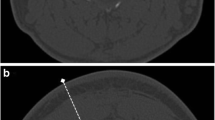Abstract
Purpose
We conducted this study to evaluate accuracy, time saving, radiation doses, safety, and pain relief of ultrasound (US)-guided periradicular injections versus computed tomography (CT)-controlled interventions in the cervical spine in a prospective randomized clinical trial.
Methods
Forty adult patients were consecutively enrolled and randomly assigned to either a US or a CT group. US-guided periradicular injections were performed on a standard ultrasound device using a broadband linear array transducer. By basically following the osseous landmarks for level definition in “in-plane techniques”, a spinal needle was advanced as near as possible to the intended, US-depicted nerve root. The respective needle tip positioning was then verified by CT. The control group underwent CT-guided injections, which were performed under standardized procedures using the CT-positioning laser function.
Results
The accuracy of US-guided interventions was 100 %. The mean time to final needle placement in the US group was 02:21 ± 01:43 min:s versus 10:33 ± 02:30 min:s in the CT group. The mean dose-length product radiation dose, including CT confirmation for study purposes only, was 25.1 ± 16.8 mGy cm for the US group and 132.5 ± 78.4 mGy cm for the CT group. Both groups showed the same significant visual analog scale decay (p < 0.05) without “inter-methodic” differences of pain relief (p > 0.05).
Conclusions
US-guided periradicular injections are accurate, result in a significant reduction of procedure expenditure under the avoidance of radiation and show the same therapeutic effect as CT-guided periradicular injections.



Similar content being viewed by others
References
Smith MD (1995) Cervical radiculopathy: causes and surgical treatment. Minn Med 78:28–50
Cyteval C, Thomas E, Decoux E, Sarrabere MP, Cottin A, Blotman F, Taourel P (2004) Cervical radiculopathy: open study on percutaneous periradicular foraminal steroid infiltration performed under CT control in 30 patients. AJNR Am J Neuroradiol 25:441–445
Ellenberg MR, Honet JC, Treanor WJ (1994) Cervical radiculopathy. Arch Phys Med Rehabil 75:342–352
Van Zundert J, Huntoon M, Patijn J, Lataster A, Mekhail N, van Kleef M (2010) 4. Cervical radicular pain. Pain Pract 10:1–17
Benny B, Azari P, Briones D (2010) Complications of cervical transforaminal epidural steroid injections. Am J Phys Med Rehabil 89:601–607
Vallee JN, Feydy A, Carlier RY, Mutschler C, Mompoint D, Vallee CA (2001) Chronic cervical radiculopathy: lateral-approach periradicular corticosteroid injection. Radiology 218:886–892
Galiano K, Obwegeser AA, Bodner G, Freund M, Maurer H, Kamelger FS, Schatzer R, Ploner F (2005) Real-time sonographic imaging for periradicular injections in the lumbar spine: a sonographic anatomic study of a new technique. J Ultrasound Med 24:33–38
Loizides A, Gruber H, Peer S, Brenner E, Galiano K, Obernauer J (2011) A new simplified sonographic approach for pararadicular injections in the lumbar spine: a CT-controlled cadaver study. AJNR Am J Neuroradiol 32:828–831
Loizides A, Gruber H, Peer S, Galiano K, Bale R, Obernauer J (2013) Ultrasound guided versus CT-controlled pararadicular injections in the lumbar spine: a prospective randomized clinical trial. AJNR Am J Neuroradiol 34:466–470
Galiano K, Obwegeser AA, Bodner G, Freund MC, Gruber H, Maurer H, Schatzer R, Fiegele T, Ploner F (2006) Ultrasound-guided facet joint injections in the middle to lower cervical spine: a CT-controlled sonoanatomic study. Clin J Pain 22:538–543
Galiano K, Obwegeser AA, Bodner G, Freund M, Maurer H, Kamelger FS, Schatzer R, Ploner F (2005) Ultrasound guidance for facet joint injections in the lumbar spine: a computed tomography-controlled feasibility study. Anesth Analg 101:579–583 (table)
Galiano K, Obwegeser AA, Bodner G, Freund MC, Gruber H, Maurer H, Schatzer R, Ploner F (2005) Ultrasound-guided periradicular injections in the middle to lower cervical spine: an imaging study of a new approach. Reg Anesth Pain Med 30:391–396
Narouze SN (2006) Ultrasound-guided cervical periradicular injection: cautious optimism. Reg Anesth Pain Med 31:87–88
Narouze SN, Vydyanathan A, Kapural L, Sessler DI, Mekhail N (2009) Ultrasound-guided cervical selective nerve root block: a fluoroscopy-controlled feasibility study. Reg Anesth Pain Med 34:343–348
Gofeld M (2008) Ultrasonography in pain medicine: a critical review. Pain Pract 8:226–240
Lachin JM (2000) Statistical considerations in the intent-to-treat principle. Control Clin Trials 21:167–189
McLean JP, Sigler JD, Plastaras CT, Garvan CW, Rittenberg JD (2009) The rate of detection of intravascular injection in cervical transforaminal epidural steroid injections with and without digital subtraction angiography. PMR 1:636–642
Jasper JF (2003) Role of digital subtraction fluoroscopic imaging in detecting intravascular injections. Pain Physician 6:369–372
Verrills P, Nowesenitz G, Barnard A (2010) Penetration of a cervical radicular artery during a transforaminal epidural injection. Pain Med 11:229–231
Windsor RE, Storm S, Sugar R, Nagula D (2003) Cervical transforaminal injection: review of the literature, complications, and a suggested technique. Pain Physician 6:457–465
Baker R, Dreyfuss P, Mercer S, Bogduk N (2003) Cervical transforaminal injection of corticosteroids into a radicular artery: a possible mechanism for spinal cord injury. Pain 103:211–215
Huntoon MA (2005) Anatomy of the cervical intervertebral foramina: vulnerable arteries and ischemic neurologic injuries after transforaminal epidural injections. Pain 117:104–111
Brouwers PJ, Kottink EJ, Simon MA, Prevo RL (2001) A cervical anterior spinal artery syndrome after diagnostic blockade of the right C6-nerve root. Pain 91:397–399
Narouze SN (2012) Ultrasound-guided cervical spine injections: ultrasound “prevents” whereas contrast fluoroscopy “detects” intravascular injections. Reg Anesth Pain Med 37:127–130
Carrino JA, Morrison WB, Parker L, Schweitzer ME, Levin DC, Sunshine JH (2002) Spinal injection procedures: volume, provider distribution, and reimbursement in the U.S. medicare population from 1993 to 1999. Radiology 225:723–729
Acknowledgments
The authors declare that no funds have been received in support of this study. No benefits in any form have been or will be received from a commercial party related directly or indirectly to the subject of this article.
Conflict of interest
The authors declare that there are no conflicts of interest.
Author information
Authors and Affiliations
Corresponding author
Rights and permissions
About this article
Cite this article
Obernauer, J., Galiano, K., Gruber, H. et al. Ultrasound-guided versus computed tomography-controlled periradicular injections in the middle and lower cervical spine: a prospective randomized clinical trial. Eur Spine J 22, 2532–2537 (2013). https://doi.org/10.1007/s00586-013-2916-0
Received:
Revised:
Accepted:
Published:
Issue Date:
DOI: https://doi.org/10.1007/s00586-013-2916-0




